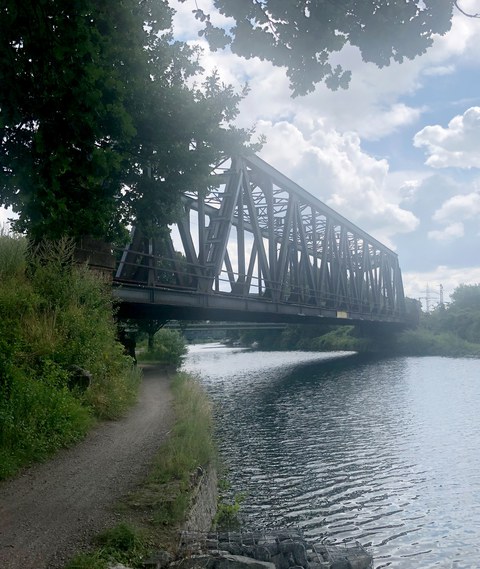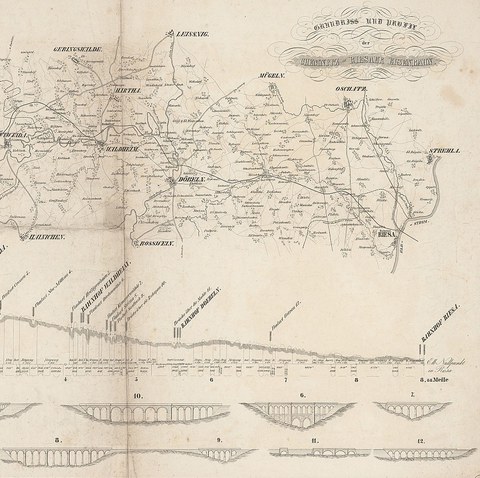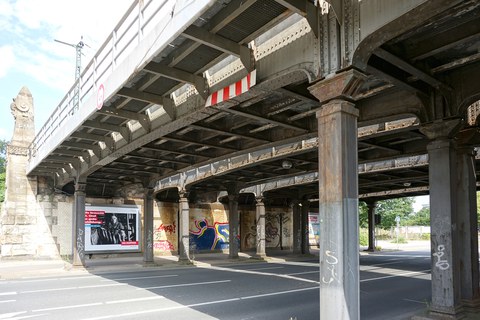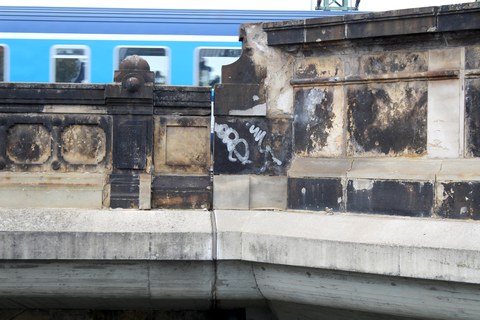Railway bridges – Monuments on the network
Table of contents
Project data
| Titel | Title Eisenbahnbrücken – Denkmale im Netz; Phase 2: – Dynamische Bilanzierungen | Railway bridges – Monuments in the network; period 2: Dynamic balancing Förderer | Funding Deutsche Forschungsgemeinschaft (DFG) / SPP 2255 Zeitraum | Period 10/2020 – 09/2024 (Phase 1) 10/2024 – 09/2027 (Phase 2) Leiter | Project manager Prof. Dr.-Ing. Steffen Marx Bearbeiterin | Contributor Johanna Monka-Birkner, M. Sc. Projektpartner | Project partner Niedersächsisches Landesamt für Denkmalpflege, Hannover |
Report from year book 2023
The bridges over the Mittelland Canal as part of a network

Railway bidge across the Mittelland Canal
In the project “Railway bridges – Monuments in the network”, railroad bridges are analyzed as parts of an overarching network. The construction of these bridges is understood as a cultural heritage in a constantly changing network. This network does not only refer to the rail network, but also comprises various other network levels. These include the networking of institutions, the use of building materials and their availability as well as the construction types themselves.
This can also be applied to other engineering structures and other networks. This was investigated using the example of the bridges over the Mittelland Canal in the area of the city of Hanover. Together with the Department for the Preservation of Monuments of Lower Saxony, the bridge structures over the Mittelland Canal were studied and analyzed. The 325 km long canal was built in several phases between 1905 and 1938 and connects the Rhine, Weser and Elbe rivers. As many roads, railroad lines and even other rivers were crossed for this ambitious construction project, a large number of new bridges had to be built.
The typology of bridges used in the construction of the canal reflects the variety of structures that could be built at the time. In addition to the traditional iron truss superstructures, innovative reinforced concrete vaults and reinforced concrete three-hinged arches with a suspended deck were developed. The overriding objective was to select the most suitable construction that did not impair the clearance profile of the canal and could be built cost-effectively and operated with low maintenance.
The canal and its bridges significantly characterize the crossed landscape. Like a railroad line, it runs linearly through the landscape and connects various cities. As it is connected to other rivers and canals, it is part of a large network of waterways. Therefore, similar criteria for the consideration of structures in the network can be applied here as for railroad bridges.
Report from year book 2022
Network layers of railway bridges

Ground plan and profile of the Chemnitz – Riesa railway with bridges (plan excerpt)
As part of SPP 2255 “Construction as cultural heritage”, the development of railway bridge construction in the phase of high modernity is currently being researched in an interdisciplinary manner as a subject of the history of construction technology and monument preservation. For this, the competences of the Institute of Concrete Structures of TU Dresden and of the Heritage Office of Lower Saxony are working together in the project “Railway Bridges – Monuments in the Network”. A fundamentally new approach is the consideration of the structures as parts of a network as well as their inherent history of change, which makes an expansion of the concept of monuments necessary and possible. The individual building is understood as an element of the dynamic development of the complex network “railway”.
The overarching infrastructural railway network has far-reaching effects on urban, settlement and landscape planning, and thus has a profound impact on the cultural-historical developments of modernity. However, the network cannot only be related to the railway network, but can be extended to various layers. These include the relevant institutions, the availability of materials and the construction types themselves, which has influences on the construction of a railway bridge. Railway bridges are influenced by many factors and can therefore not only be considered as individual structures in their monument conservation assessment. As part of a network, railway bridges have to fulfil their infrastructural function and carry a line. Due to this clearly defined, permanent function, a necessary degree of changeability of railway bridges must be ensured. In contrast to this are the goals of monument preservation, which demand the greatest possible preservation as well as the integrity and authenticity of the structures. This always leads to challenges and makes a critical examination of both interests necessary.
In addition, railway bridges are constantly changing structures, as their functionality and conservation value must be secured through maintenance, repair and renewal due to increased demands. This history of change in railway bridges is, in retrospect, part of the monument and, looking ahead, a boundary condition for any monument preservation concept.
Report from year book 2021
Railway bridges – Monuments in the network

Bridge crossing Altenbekener Damm, Hanover
The project aims to conduct interdisciplinary research into the development of railway bridge construction in the phase of the High Modern Age (1880-1940) as a subject of the history of structural engineering and monument preservation. It thus improves the basis for the systematic evaluation of railway bridges as cultural monuments worthy of preservation and places their further development as "monuments in the network" on a broader basis, which is not yet available according to the current state of research and in the practice of monument preservation.
Using representative examples from the present-day federal state of Lower Saxony, railway bridges are to be investigated as important parts of an overarching infrastructural network which has far-reaching effects on urban, settlement and landscape planning and thus has a deep impact on the cultural-historical developments of the modern age. The individual construction is understood as an element of the dynamic development of the complex network "railway". A further focus of the research project is the development of a coordinate system in the history of construction technology. In particular, the developments in construction technology, construction history and social developments in the period of the High Modern Age will be analysed, so that a classification of the example buildings into the superordinate overall context is possible.
The research project aims to examine the existing criteria for the evaluation of railway bridges of the High Modern Age in terms of their status as historical monuments on the basis of the research results, to develop them further and to design a scientific methodology for their classification. The project is based on the hypothesis that this classification is not only possible through the classical monographic view of the individual object, but that the bridges must be viewed as part of the network, so that the monument value can be developed more comprehensively.
Report from year book 2020
Railway bridges – monuments in the network

Railing on the Marienbrücke, Dresden
The aim of the project is the interdisciplinary research of the development of railroad bridge construction in the period of High Modernism (1880–1940) as a subject of the history of construction technology and monument preservation. This will improve the basis for the systematic evaluation of railroad bridges as cultural monuments worth preserving and demonstrate their development into “monuments in the railway network”. This investigation has not yet been carried out comprehensively according to the current state of research and in practice of monument preservation.
The overarching infrastructural railway network has far-reaching effects on urban, settlement and landscape planning. It is deeply affecting the cultural-historical developments of the modern age. Because railway bridges are important parts of this network, representative examples from the present-day states of Lower Saxony and Saxony will be examined. The individual structure is understood as an element of the dynamic development of the complex “railway” network. The network perspective allows a fundamentally new approach to monumental objects and an expansion of the term “monument”. This results in the aim of developing further evaluation criteria for the monument preservation value and capability of infrastructure buildings.
Railway bridges are constantly changing structures, as their functionality and preservation value must be secured through maintenance, repair and replacement due to increased requirements. This history of change is, in retrospect, part of the monument and, looking forward, a boundary condition for any monument preservation concept. Another focus of the research project is the development of a coordinate system for the history of construction. The developments in building technology, construction history and society during the period of High Modernism are analysed so that the exemplary buildings can be placed in the overall context.
In this research project, the existing criteria for the heritage assessment of high-modern railway bridges will be examined and further developed based on the research results. A scientific methodology for their classification will be developed. As a pilot project, it aims at a nationwide transferability of the results for the entire railway network.
